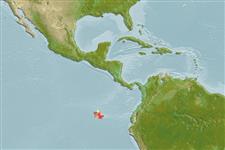Environment: milieu / climate zone / depth range / distribution range
Ökologie
seewasser riff-verbunden; tiefenbereich 0 - 10 m (Ref. 57883). Tropical
Southeast Pacific: Galapagos Islands.
Size / Gewicht / Alter
Maturity: Lm ? range ? - ? cm
Max length : 7.0 cm TL Männchen/unbestimmt; (Ref. 11482)
Rückenflossenweichstrahlen (insgesamt): 68-80; Afterflossenweichstrahlen: 51 - 59; Wirbelzahl: 39 - 43. This species is characterized by the following: vertebrae 11-12 + 27-31 = 39-43, dorsal fin rays 68-80, anal fin rays 51-59; outer pseudoclasper with a broad base and long supporter with sharp, pointed tip; inner pseudoclasper is anteriorly inclined, of about length of outer pseudoclasper, with sharp, spine-like tip anteriorly and fleshy flap posteriorly; isthmus between pseudoclaspers wide, penis with abrupt change in thickness; opercular spine with a single, sharp tip; cheeks naked or with few isolated scales (less than 10 scales all together); otolith length: height ratio 2.1-2.2; upper preopercular pore absent (Ref. 57883).
Inhabits rocky crevices (Ref. 11482). Two paratypes that were collected at low tide between blocks of lava in about 50 cm of water, were observed to move slowly close to the sand bottom. Experiments that were carried out showed that O. deroyi can tolerate a wide
variation in salinity, but not the low salinity in which O. galapagosensis lives. Consequently, there is an ecological barrier separating the two species. Only about five embryos were observed in ripe females (Ref. 57883).
Life cycle and mating behavior
Geschlechtsreife | Fortpflanzung | Ablaichen | Eier | Fecundity | Larven
Møller, P.R., W. Schwarzhans and J.G. Nielsen, 2005. Review of the American Dinematichthyini (Teleostei: Bythitidae). Part II. Ogilbia. aqua, J. Ichthyol. Aquat. Biol. 10(4):133-207. (Ref. 57883)
IUCN Rote Liste Status (Ref. 130435)
Bedrohung für Menschen
Harmless
Nutzung durch Menschen
Fischereien: nicht kommerziell
Mehr Information
NamenSynonymeMetabolismusRäuberÖkotoxikologieFortpflanzungGeschlechtsreifeAblaichenSpawning aggregationFecundityEierEientwicklung
ReferenzenAquakulturAquakultur ProfilZuchtlinienGenetikElectrophoresesVererbbarkeitKrankheitenVerarbeitungNutrientsMass conversion
PartnerBilderStamps, Coins Misc.LauteCiguateraGeschwindigkeitSchwimmstilKiemenoberflächeOtolithsGehirngrößeSehfähigkeit
Tools
Zusatzinformationen
Download XML
Internet Quellen
Estimates based on models
Preferred temperature (Ref.
123201): 23.6 - 24.6, mean 23.9 °C (based on 12 cells).
Phylogenetic diversity index (Ref.
82804): PD
50 = 0.5000 [Uniqueness, from 0.5 = low to 2.0 = high].
Bayesian length-weight: a=0.00389 (0.00180 - 0.00842), b=3.12 (2.94 - 3.30), in cm total length, based on all LWR estimates for this body shape (Ref.
93245).
Trophic level (Ref.
69278): 3.3 ±0.5 se; based on size and trophs of closest relatives
Widerstandsfähigkeit (Ref.
120179): niedrig, Verdopplung der Population dauert 4,5 - 14 Jahre. (Assuming Fec < 100).
Fishing Vulnerability (Ref.
59153): Low vulnerability (10 of 100).
